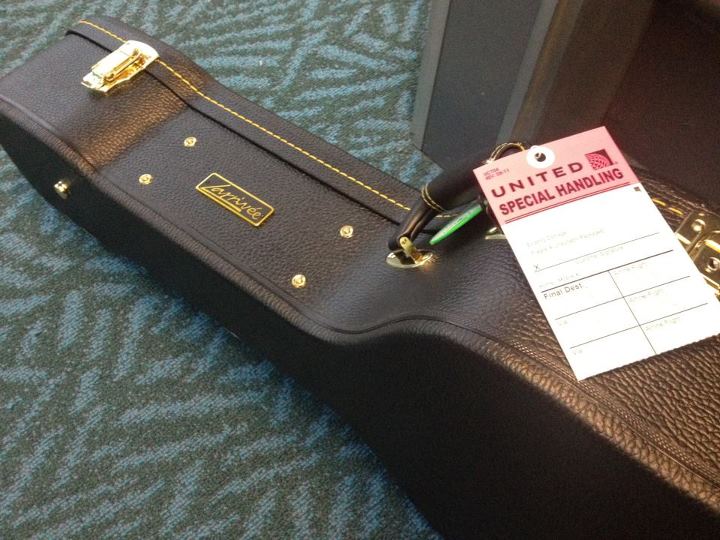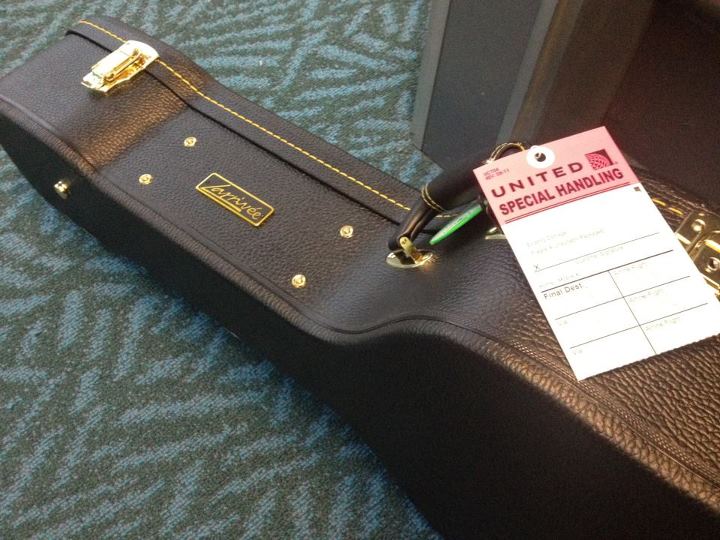Flying With A Guitar

While I own several guitars, I previously have never attempted flying with a guitar. A quick Google search on the Internet reveals a lot of confusion about the process, as well as a few horror stories about damaged or stolen guitars. An infamous story of breakage ended in a viral internet video known as “United Breaks Guitars”:
When I was in Argentina in 2011, I ended up having more free time than I thought I would have. In those moments, I really missed having access to a guitar that I could pick up and play. I went down to a local guitar store thinking I would buy something cheap, but it’s definitely hard going from a $1,000 – $2,000 guitar back down to a $100 one. Plus, I didn’t really want to deal with selling it when I was leaving.
So for this trip I decided I would bring a guitar with me. The two guitars I had access to back home were an expensive Morgan Concert Series guitar, or a $750 Takamine. The Takamine would have been a good choice, except I don’t really like it all that much. Since I was looking for an excuse to buy a new guitar, I went out and bought a Larrivee D-03R Rosewood acoustic for about $1,200 CAD. While having a $1,200 guitar stolen or damaged would suck, it’s something I could probably live with (unlike the Morgan).
I was flying United Airlines from Vancouver to Buenos Aires (via Houston), and I fully expected to have to check my guitar as baggage. To that end, I loosened all the strings on the guitar and packed all the empty areas inside the case with socks, underwear and whatever other loose clothing I had. I also wrapped the headstock with a small tower to keep it in place and to protect it a bit better.
When I arrived in Vancouver and checked in at the United counter, I asked her what I should do with my guitar. She actually recommended that I gate-check it, which I knew was possible but I thought it was something you usually have to fight for. What gate-checking meant is that I was allowed to simply leave it at the entrance to the plane (where people usually leave baby strollers) and also pick it up there when we landed. Since I was expecting to have to pay $70 to check an extra bag (the guitar case) as luggage, I asked her what the price would be for taking my guitar – she said not to worry about it, which was great.
When I got to the gate I approached the agent there and told her I would be gate checking my guitar. She filled out some basic paperwork and attached a tag to my guitar with my flight information. When I boarded the plane, I simply placed my guitar next to the agent standing next to the other gate-checked items, and boarded.
When we arrived in Houston, my guitar was waiting for me immediately upon exiting the airplane.
My main concern with having to check my guitar as luggage wasn’t that it would get damaged, but mostly that it would be sitting on the baggage carousel by itself while I was stuck in a custom’s line. Thankfully gate-checking the guitar is a much better option since you drop your guitar off at the last possible moment, and pick it up at the first possible one when you land.
The process from Houston to Buenos Aires was essentially the same, except that I didn’t have to get another tag put on my guitar (since it already had my Buenos Aires flight information). When I exited the plane in Buenos Aires, my guitar wasn’t anywhere to be seen. But I just waited about ten minutes and finally someone brought it out to me.
When I got to my apartment in Buenos Aires, I decided to open it up and do an inspection. Of course, everything was fine, so I tightened all the strings up and re-tuned it. I found the guitar kept going out of tune for the first few days (possibly due to the humidity differences between Vancouver and Buenos Aires), but it eventually settled back down and stayed in tune after a few days.
All in all it was a pretty easy process, and one I’m definitely going to try again in the future on a few different airlines. So if you’re thinking about flying with your guitar, give it a try – hopefully it’ll be as easy as it was for me.
